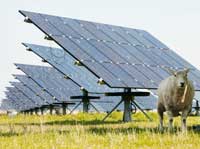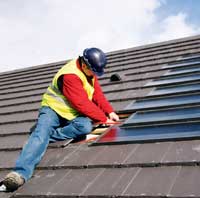Should you go for solar PV? We answer your questions

What a difference a few months can make. Not so long ago, solar PV panels were the poor relation in the green energy family, with a payback period of up to 25 years. But the new Feed-in Tariff (FiT) scheme, that provides payments for electricity generated by small-scale anaerobic digestion, hydro, CHP (combined heat and power) and wind power schemes, has changed all that.
“The FiT scheme has been criticised for lacking in ambition compared with other schemes in Europe because it is expected to deliver only 2% of UK electricity production by 2020,” says Jonathan Scurlock, the NFU’s chief adviser on renewable energy and climate change. “But with a typical return on investment of 8-12%, the Feed-in Tariff makes solar photovoltaic generation a much more attractive investment than it had been previously.”
The Feed-in Tariff, which is available for schemes generating less than 5MW per year, is paid by electricity suppliers whether this green energy is consumed by the generator or sold to feed in to the national supply. So, on top of the payment itself, farm-based generators can replace all or at least some of the electricity they currently purchase and sell any surplus.
There are two principal options, invest in a barn roof system or field array or leave the investment to someone else by renting out roof or field space for the duration of the guaranteed 25-year life of the FiT scheme.
• What exactly is a solar panel?
Light shining on a solar panel creates an electric field across layers of silicon in each cell, causing electricity to flow. This DC power can be used straight away or fed into the national grid. Photovoltaic cells were first developed by Bell Laboratories in 1954.
• Aren’t solar panels a bit delicate for putting on a shed roof?
They’re actually quite robust as there are no moving parts. PV modules have an expected lifetime of 45-50 years, albeit with a progressive loss in performance efficiency.
• What about maintenance?
PV modules need no routine maintenance other than occasionally being cleaned. Inverters and control gear will typically need replacing every 10 years or so.
• Where’s the best place to site solar panels?
Cornwall and along the south coast provide the best locations but anywhere that solar panels can be orientated between the south-east to south-west is good.
• What about a good location on the farm?
Installing PV panels on a south-facing barn roof is ideal for energy capture but they can also be mounted in ground-mounted frames in arrays around field margins – as long as they are not shadowed by hedges or trees – or across whole fields.
 • Is a roof installation best?
• Is a roof installation best?
It’s likely to be a little more expensive than a ground array but there are advantages – the panels are located out of harm’s way, for one thing, and will have less visual impact.
• Are some buildings better suited than others?
They clearly need to be strong enough to take the weight of the installation. Also, given the long service life of PV panels, buildings should have a lifetime at least as long as the panels.
• What about the building’s use; does that matter?
Only to the extent that it makes sense to install panels on buildings that consume the most electricity – such as grainstores and intensive pig and poultry sheds and vegetable packhouses. Glasshouses may also be suitable if the panels can be mounted over storage areas or corridors, etc.
• Is planning permission needed?
Best check with the local planning authority. The government’s plan is that renewable energy micro-generation equipment installed on commercial buildings will be covered by Permitted Development rights (as is the case for most domestic installations) but this plan is still at the consultation stage.
• Is there any limit to the size of a PV panel installation?
Apart from the size of the roof and the cost of installation, the only limiting factor is the 5mW ceiling of the FiT scheme.
• How does the scheme work?
The Government’s Feed-in Tariff is worth from 29p to 41p per kilowatt-hour (p/kWh) depending on the scale of the installation. Systems from 100kW to 5MW generating capacity attract the lowest figures, systems of less than 4kW earn the highest rates.
• Is it a fixed rate or dependent on markets?
The tariffs for new entrants have been set for the first two years; from April 2012 they start to reduce progressively in anticipation of falling capital costs for PV equipment. However, once you’ve signed up, the tariffs are index-linked to keep up with inflation and guaranteed for the next 25 years.
• Who pays the tariff?
Your electricity supplier makes the payments based on meter readings of the amount of power generated.
• Does the Feed-in Tariff pay enough to get a decent return?
Not on its own, but the electricity generated can be consumed on site to reduce what you have to buy in. Also, any surplus can be sold for distribution via the national grid, being purchased by your electricity supplier who will have an obligation to supply power from renewable sources.
• What’s a typical return on the investment?
The NFU calculates 8-12%. A typical small system in the 4-10kW class would qualify for a Feed-in Tariff payment of 36.1p/kWh up to April 2012, so a 9.9kWh installation, likely to cost £35,000-40,000, could earn £3300-3800 from the tariff, with savings in purchased electricity and sales of any surplus coming on top.
A £300,000-350,000 scheme of 99kWh capacity would qualify for a FiT rate of 31.4p/kWh and generate an income of £30,000-35,000 a year before any surplus sales.
• Do all solar panel systems qualify?
Equipment and installers must be approved if the scheme is to qualify for Feed-in Tariff payments. The scheme itself will be accredited by OFGEM, the electricity industry regulator, through its Renewable & CHP Register.
• Are there different ways of buying a system?
Lease purchase schemes are being introduced with payments made over six or seven years qualifying as operating expenditure.
• What about renting my roof or some land?
Solar development companies like Ecotricity and INRG Solar are starting to offer contracts for renting land or roof space for electricity generation and they take care of the capital investment involved and ongoing maintenance costs. Negotiating to acquire ownership of the installation at the end of the 25-year Feed-in Tariff period would provide ongoing electricity cost savings and sales income from a system that could have a life of 50 years or more.
• Are the payments attractive?
This is an immature market, so annual lease payments being quoted at present are pretty variable, notes the NFU. Ground rents for a field array range from just £750 to more than £2500/ha for the 25-year lifetime of the Feed-in Tariff. As far as buildings are concerned, developers will be most interested in larger roof areas – say 700 to 2200sq m capable of supporting a 100-300kW capacity installation.
• How do I get started?
The NFU recommends doing a detailed energy audit of the farm. That will show the savings you can make by using home-generated power instead of of bought-in supplies as well the potential income from sales of any surplus. It will also help you decide on the scale of your solar panel installation. Talk to your professional advisers before entering negotiations, too.
• For more information on renewable energy visit www.nfuonline.com
Contacts
www.alphawatt.co.uk 07884 384 273
www.beba-energy.co.uk 01442 220 100
www.britisheco.com 01753 201 322
www.ecotricity.co.uk 01453 756 111
www.esconrg.com 020 7722 9666
www.idein.co.uk 01202 802 202
www.ownergy.co.uk 020 7173 5010
www.pvsp.co.uk 01205 722 352
www.r-eco.co.uk 01736 368 367
www.renenergy.co.uk 0845 225 2727
www.7y.co.uk 01568 610 077
www.solarpowerintl.co.uk 0844 504 1317
www.solaruk.com 07892 526 368
www.solarcentury.co.uk 020 7803 0180
www.the-green-company.com 0800 0787 243
Supplier directories

